Investigating the Potential Impact of Future Climate Change on UK Supermarket Building Performance
Abstract
1. Introduction
- A new record (38.7 °C), 25 July, Cambridge University Botanic Gardens (Cambridgeshire).
- A new winter record (21.2 °C), 26 February, Kew Gardens (London); the first time 20 °C has been reached in the UK in a winter month.
- A new December record (18.7 °C), 28 December, Achfary (Sutherland).
- A new February minimum record (13.9 °C), 23 February, Achnagart (Highland).
2. Methodology
2.1. Background
2.2. Thermal Analysis Simulation (TAS EDSL) 3D Modelling
2.3. Modelling Process
2.4. Simulation Process
2.5. UK Building Regulation Studio 2013
2.6. Future Weather Data Simulation Process
3. Results and Discussion
3.1. Statistical Analysis of the Key Performance Indicators
3.1.1. Total Annual Energy Consumption Variation
3.1.2. Total Carbon Dioxide (CO2) Emissions Variation
3.1.3. Annual Electricity Grid Comparison Analysis
3.1.4. Percentage of Cooling Demand Variation
3.1.5. Percentage of Heating Demand Reduction
3.2. Analysis and Comparison of Significant Parameters under the Worst-Case Scenario
3.2.1. Percentage of Heating Demand Reduction
3.2.2. Analysis of Dry Bulb Temperature
3.2.3. Analysis and Comparison of Cooling Load Profile
3.3. Analysis and Comparison of Significant Parameters under the Worst-Case Scenario
4. Conclusions
Author Contributions
Funding
Conflicts of Interest
References
- CCA Climate Change Act. 2008. Available online: https://www.legislation.gov.uk/ukpga/2008/27/pdfs/ukpga_20080027_en.pdf (accessed on 16 November 2020).
- Dilshad, S.; Kalair, A.R.; Khan, N. Review of carbon dioxide (CO2) based heating and cooling technologies: Past, present, and future outlook. Int. J. Energy Res. 2019, 44, 1408–1463. [Google Scholar] [CrossRef]
- Khan, N.; Dilshad, S.; Khalid, R.; Kalair, A.R.; Abas, N. Review of energy storage and transportation of energy. Energy Storage 2019, 1. [Google Scholar] [CrossRef]
- De Wilde, P.; Coley, D. The implications of a changing climate for buildings. Build. Environ. 2012, 55, 1–7. [Google Scholar] [CrossRef]
- Kendon, M.; McCarthy, M.; Jevrejeva, S.; Matthews, A.; Sparks, T.; Garforth, J. State of the UK climate 2019. Int. J. Climatol. 2020, 40, 1–69. [Google Scholar] [CrossRef]
- Tassou, S.A.; Ge, Y.; Hadawey, A.; Marriott, D. Energy consumption and conservation in food retailing. Appl. Therm. Eng. 2011, 31, 147–156. [Google Scholar] [CrossRef]
- Randall, D.A.; Wood, R.A.; Bony, S.; Colman, R.; Fichefet, T.; Fyfe, J.; Kattsov, V.; Pitman, A.; Shukla, J.; Srinivasan, J. Climate models and their evaluation. In Climate Change 2007: The Physical Science Basis. Contribution of Working Group I to the Fourth Assessment Report of the IPCC (FAR); Cambridge University Press: Cambridge, UK, 2007; pp. 589–662. [Google Scholar]
- de Alegría Mancisidor, I.M.; Díaz de Basurto Uraga, P.; Martínez de Alegría Mancisidor, I.; Ruiz de Arbulo López, P. European Union’s renewable energy sources and energy efficiency policy review: The Spanish perspective. Renew. Sustain. Energy Rev. 2009, 13, 100–114. [Google Scholar] [CrossRef]
- European Parliament. Fact Sheets on the European Union. Available online: https://www.europarl.europa.eu/factsheets/en/home (accessed on 11 December 2020).
- IPCC. Climate Change 2014: Synthesis Report. Available online: https://www.ipcc.ch/site/assets/uploads/2018/05/SYR_AR5_FINAL_full_wcover.pdf (accessed on 16 November 2020).
- Met Office. UK Climate Projections (UKCP). Available online: https://www.metoffice.gov.uk/research/approach/collaboration/ukcp/index (accessed on 16 November 2020).
- Murphy, J.; Sexton, D.; Jenkins, G.; Boorman, P.; Booth, B.; Brown, K.; Clark, R.T.; Collins, M.; Harris, G.; Kendon, E. Climate change projections for the UK (UKCP09). AGUFM 2010, 2010, GC31E-06. [Google Scholar]
- Kalogirou, S.A. Generation of typical meteorological year (TMY-2) for Nicosia, Cyprus. Renew. Energy 2003, 28, 2317–2334. [Google Scholar] [CrossRef]
- Wilcox, S.; Marion, W. Users Manual for TMY3 Data Sets; Technical Report NREL/TP-581-43156; National Renewable Energy Laboratory: Golden, CO, USA, 2008.
- First, P.J. Global warming of 1.5 C. An IPCC Special Report on the Impacts of Global Warming of 1.5 C Above Pre-Industrial Levels and Related Global Greenhouse Gas Emission Pathways, in the Context of Strengthening the Global Response to the Threat of Climate Change; IPPC: Geneva, Switzerland, 2018. [Google Scholar]
- Amoako-Attah, J.; B-Jahromi, A. Impact of future climate change on UK building performance. Adv. Environ. Res. 2013, 2, 203–227. [Google Scholar] [CrossRef]
- Dimoudi, A.; Tompa, C. Energy and environmental indicators related to construction of office buildings. Resour. Conserv. Recycl. 2008, 53, 86–95. [Google Scholar] [CrossRef]
- Gustavsson, L.; Joelsson, A.; Sathre, R. Life cycle primary energy use and carbon emission of an eight-storey wood-framed apartment building. Energy Build. 2010, 42, 230–242. [Google Scholar] [CrossRef]
- Loveland, J.E.; Brown, G.Z. Impacts of Climate Change on the Energy Performance of Buildings in the United States; Office of Technology Assesment United States Congress: Washington, DC, USA, 1996.
- Gaterell, M.R.; McEvoy, M.E. The impact of climate change uncertainties on the performance of energy efficiency measures applied to dwellings. Energy Build. 2005, 37, 982–995. [Google Scholar] [CrossRef]
- Hacker, J.N.; De Saulles, T.P.; Minson, A.J.; Holmes, M.J. Embodied and operational carbon dioxide emissions from housing: A case study on the effects of thermal mass and climate change. Energy Build. 2008, 40, 375–384. [Google Scholar] [CrossRef]
- Hacker, J.N.; Holmes, M.J.; Belcher, S.E.; Davies, G. Climate Change and the Indoor Environment: Impacts and Adaptation; Chartered Institution of Building Services Engineers: London, UK, 2005; ISBN 1903287502. [Google Scholar]
- Lomas, K.J.; Ji, Y. Resilience of naturally ventilated buildings to climate change: Advanced natural ventilation and hospital wards. Energy Build. 2009, 41, 629–653. [Google Scholar] [CrossRef]
- Barclay, M.; Sharples, S.; Kang, J.; Watkins, R. The natural ventilation performance of buildings under alternative future weather projections. Build. Serv. Eng. Res. Technol. 2012, 33, 35–50. [Google Scholar] [CrossRef]
- Li, D.H.W.; Yang, L.; Lam, J.C. Impact of climate change on energy use in the built environment in different climate zones—A review. Energy 2012, 42, 103–112. [Google Scholar] [CrossRef]
- Belcher, S.; Hacker, J.; Powell, D. Constructing design weather data for future climates. Build. Serv. Eng. Res. Technol. 2005, 26, 49–61. [Google Scholar] [CrossRef]
- CIBSE. TM 48, Use of Climate Change Scenarios for Building Simulation: The CIBSE Future Weather Years. Available online: https://www.cibse.org/knowledge/knowledge-items (accessed on 11 December 2020).
- Virk, G.; Mylona, A.; Mavrogianni, A.; Davies, M. Using the new CIBSE design summer years to assess overheating in London: Effect of the urban heat island on design. Build. Serv. Eng. Res. Technol. 2015, 36, 115–128. [Google Scholar] [CrossRef]
- Eames, M.; Kershaw, T.; Coley, D. On the creation of future probabilistic design weather years from UKCP09. Build. Serv. Eng. Res. Technol. 2011, 32, 127–142. [Google Scholar] [CrossRef]
- Clarke, J. Energy Simulation in Building Design, 2nd ed.; Routledge: London, UK, 2001; ISBN 9780080505640. [Google Scholar]
- CIBSE. Applications Manual AM11: Building Energy and Environmental Modelling; CIBSE: London, UK, 1998. [Google Scholar]
- Crawley, D.B. Impact of Climate Change on Buildings. In Proceedings of the CIBSE/ASHRAE International Conference, Edinburgh, UK, 24–26 September 2003. [Google Scholar]
- Alsaadani, S.; Bleil De Souza, C. Performer, consumer or expert? A critical review of building performance simulation training paradigms for building design decision-making. J. Build. Perform. Simul. 2019, 12, 289–307. [Google Scholar] [CrossRef]
- EDSL. TAS Software Package for the Thermal Analysis of Buildings. Available online: http://www.edsl.net/main/Support/Documentation.aspx (accessed on 16 November 2020).
- Bahadori-Jahromi, A.; Rotimi, A.; Mylona, A.; Godfrey, P.; Cook, D. Impact of window films on the overall energy consumption of existing UK hotel buildings. Sustainability 2017, 9, 731. [Google Scholar] [CrossRef]
- Salem, R.; Bahadori-Jahromi, A.; Mylona, A.; Godfrey, P.; Cook, D. Investigating the potential impact of energy-efficient measures for retrofitting existing UK hotels to reach the nearly zero energy building (nZEB) standard. Energy Effic. 2019, 12, 1577–1594. [Google Scholar] [CrossRef]
- Eames, M.; Ramallo-Gonzalez, A.; Wood, M. An update of the UK’s test reference year: The implications of a revised climate on building design. Build. Serv. Eng. Res. Technol. 2016, 37, 316–333. [Google Scholar] [CrossRef]
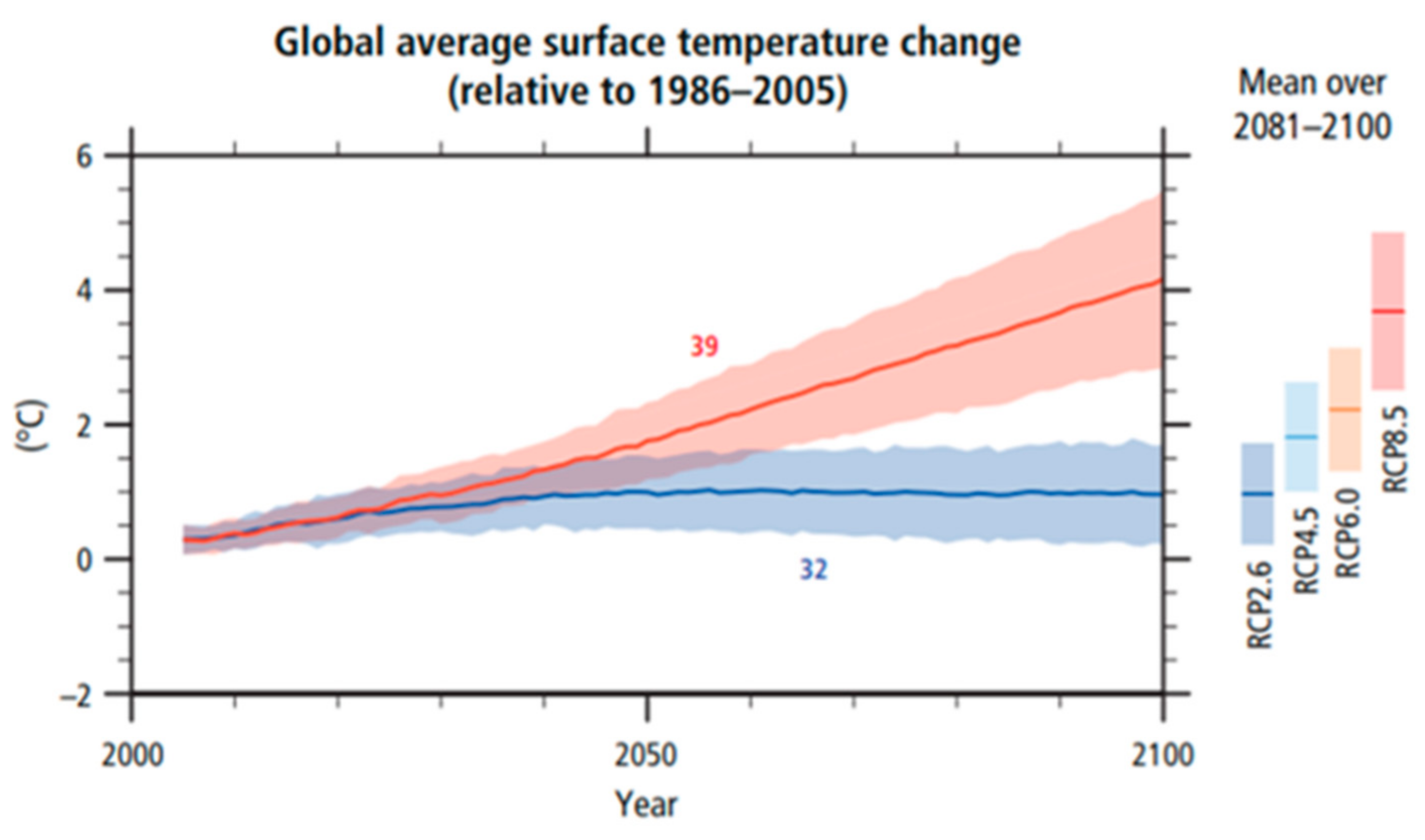
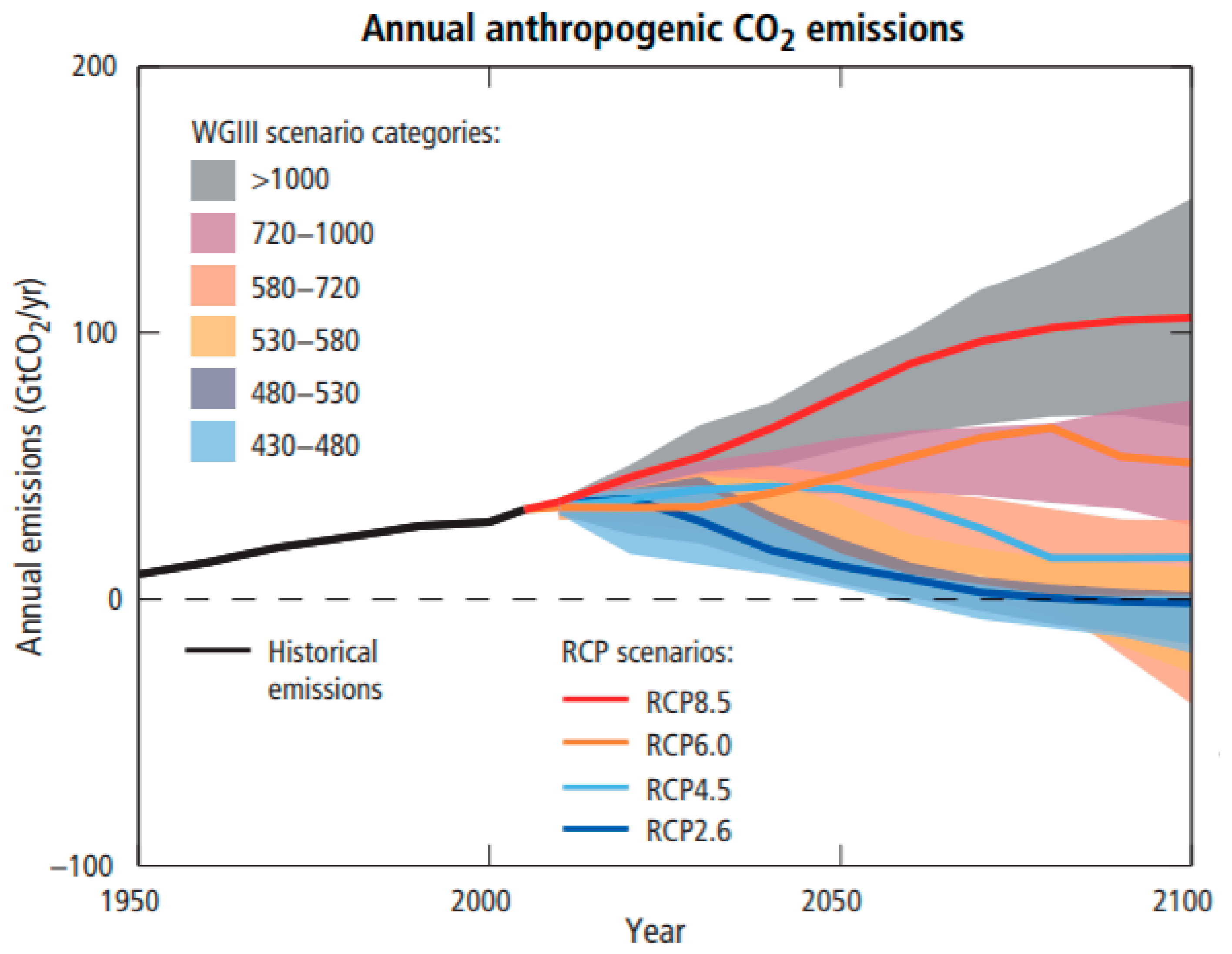
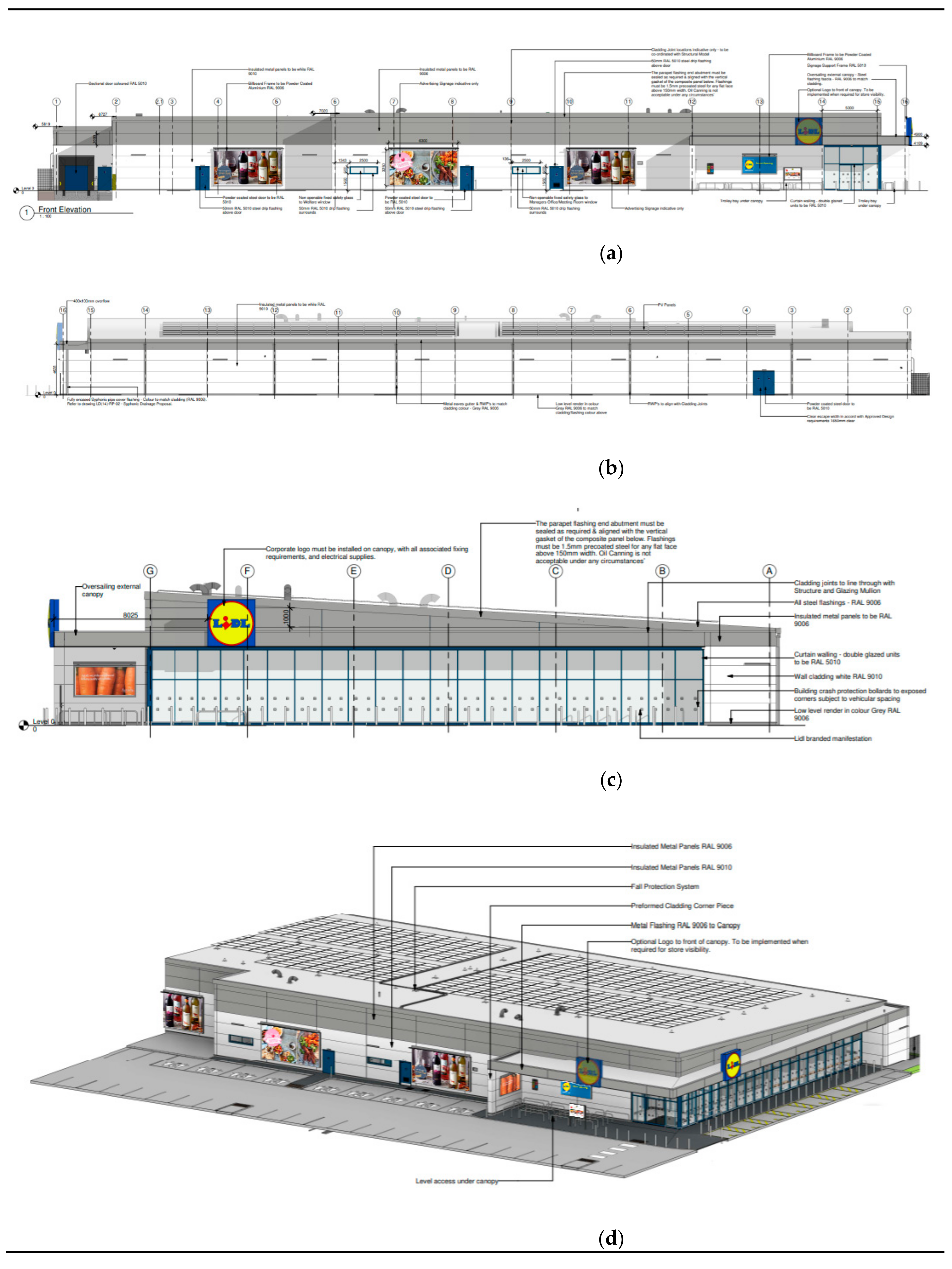
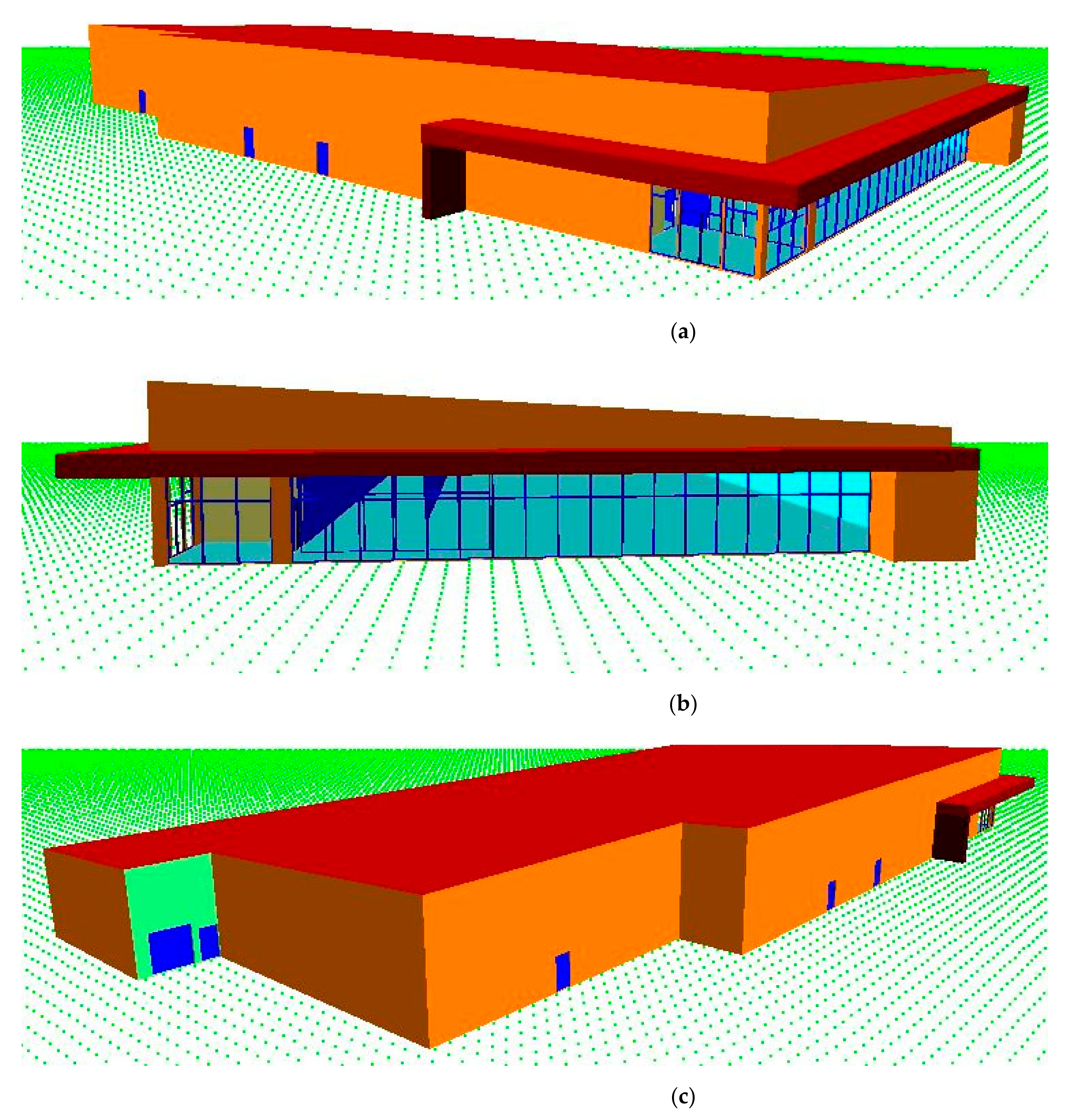
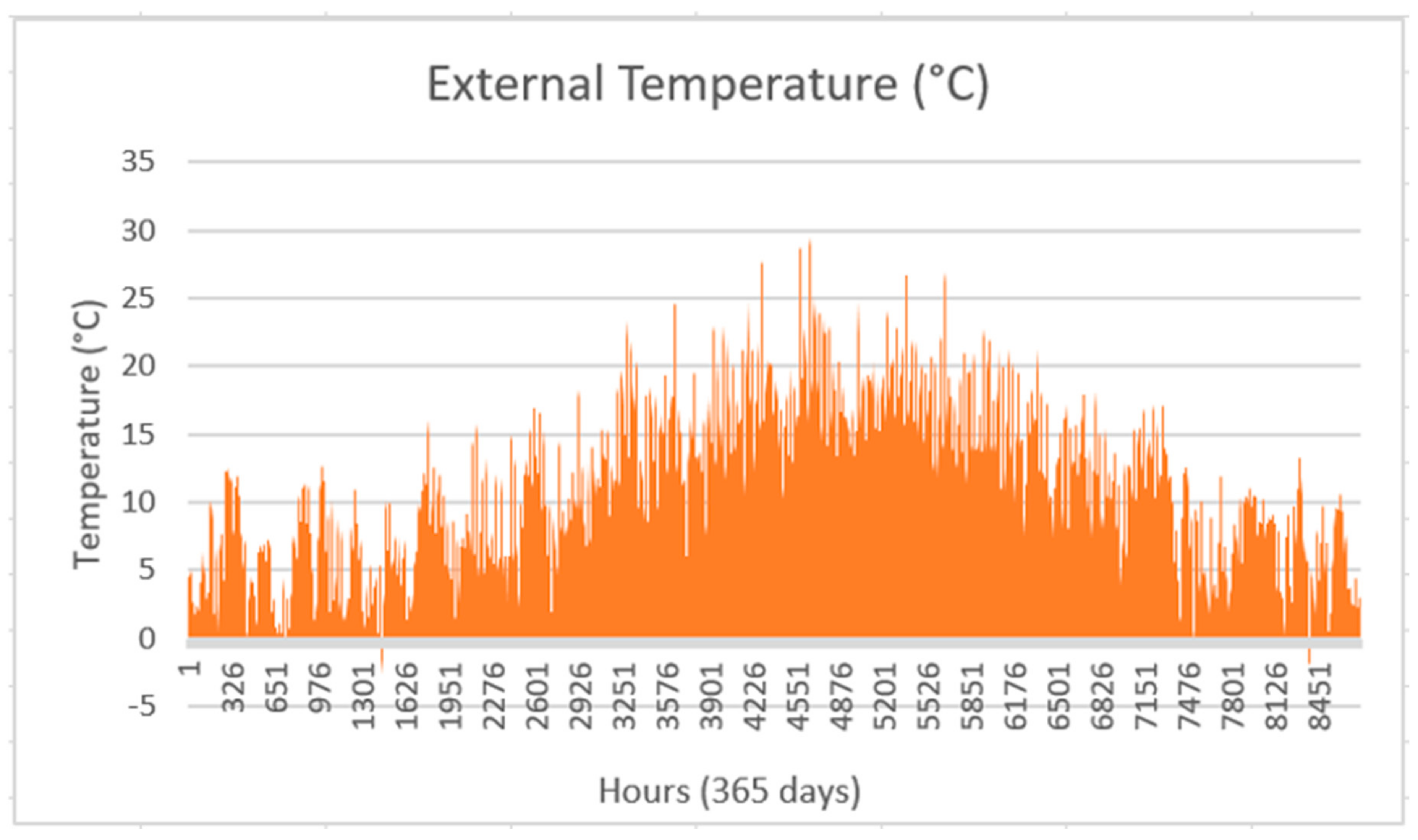
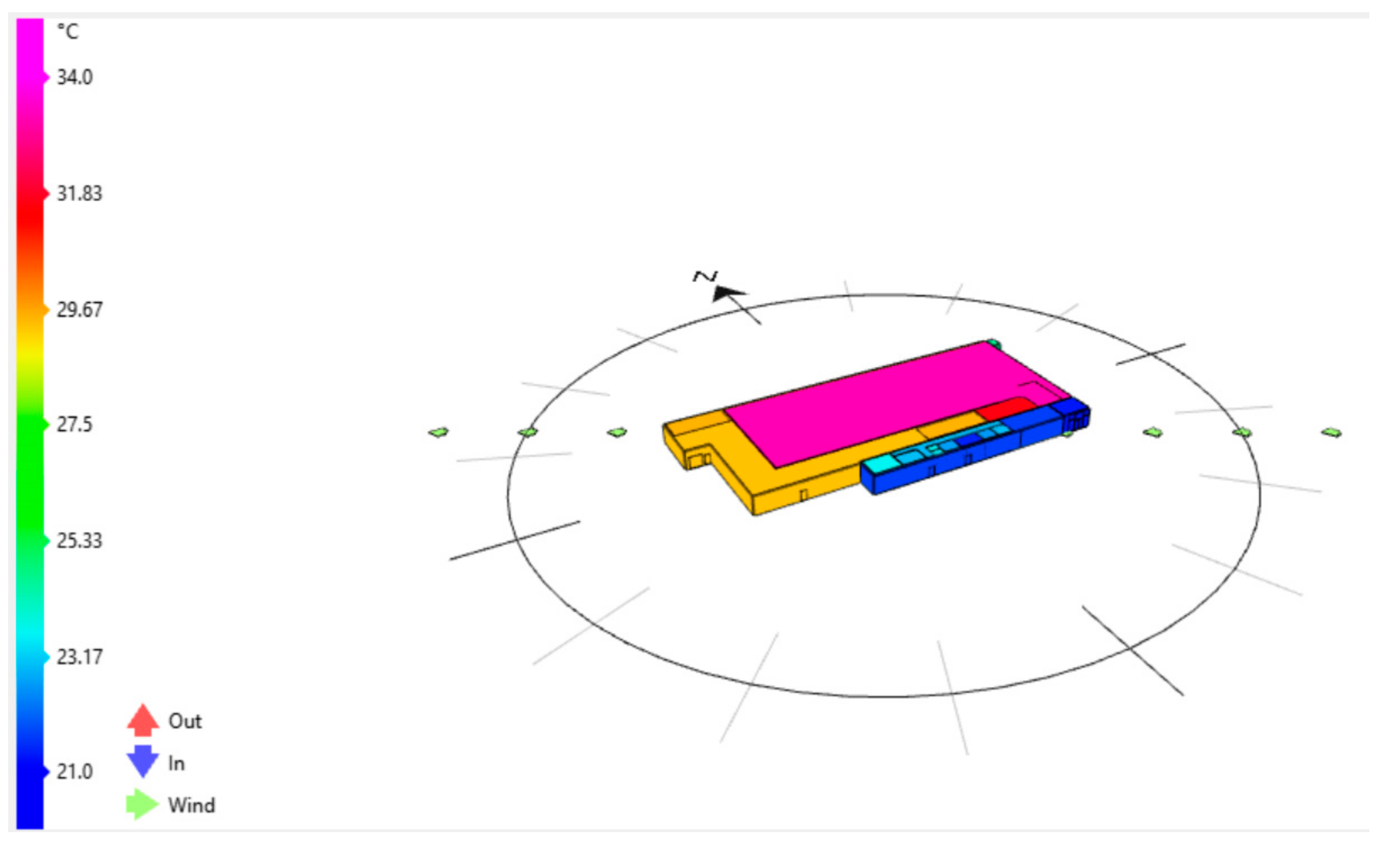
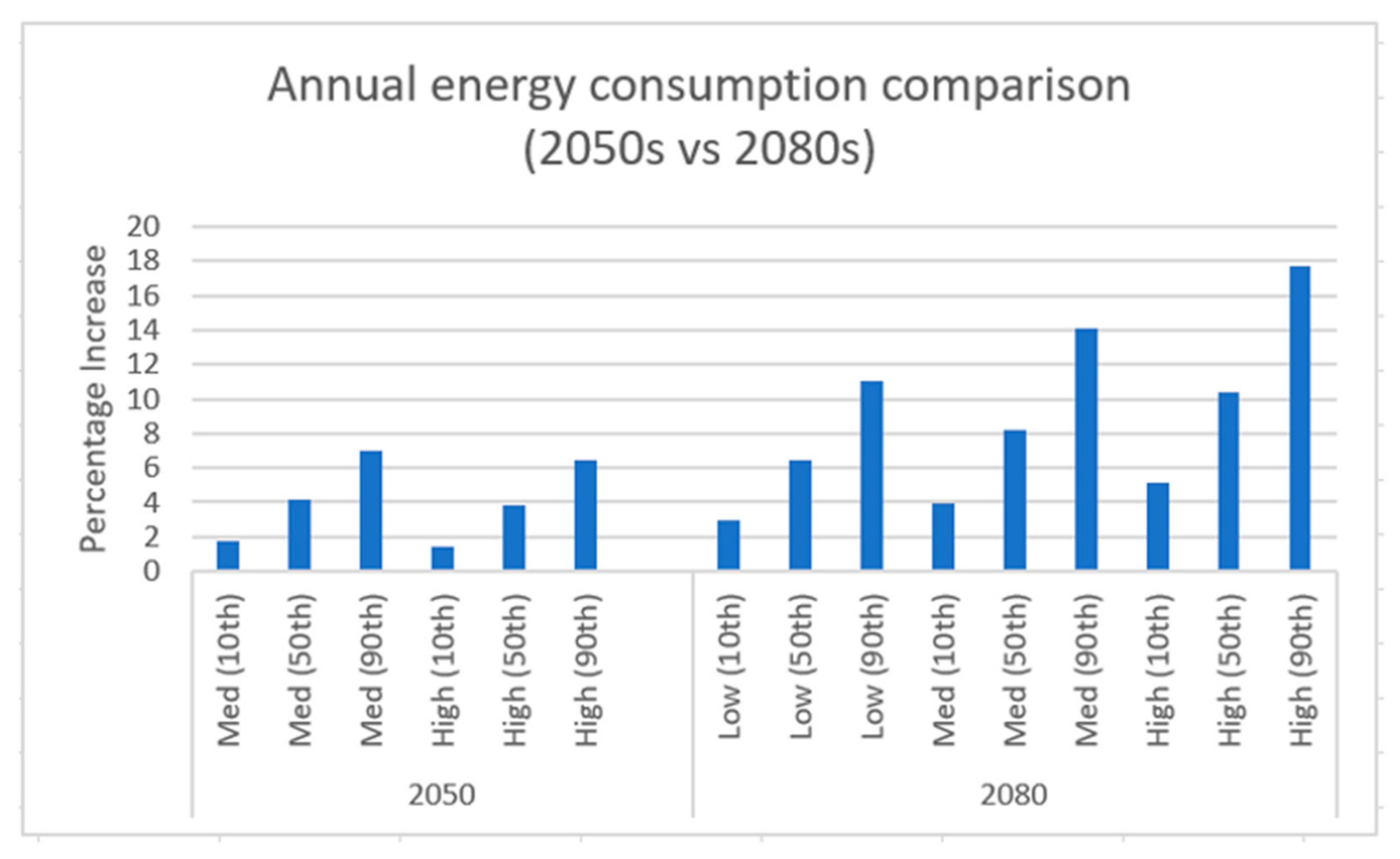
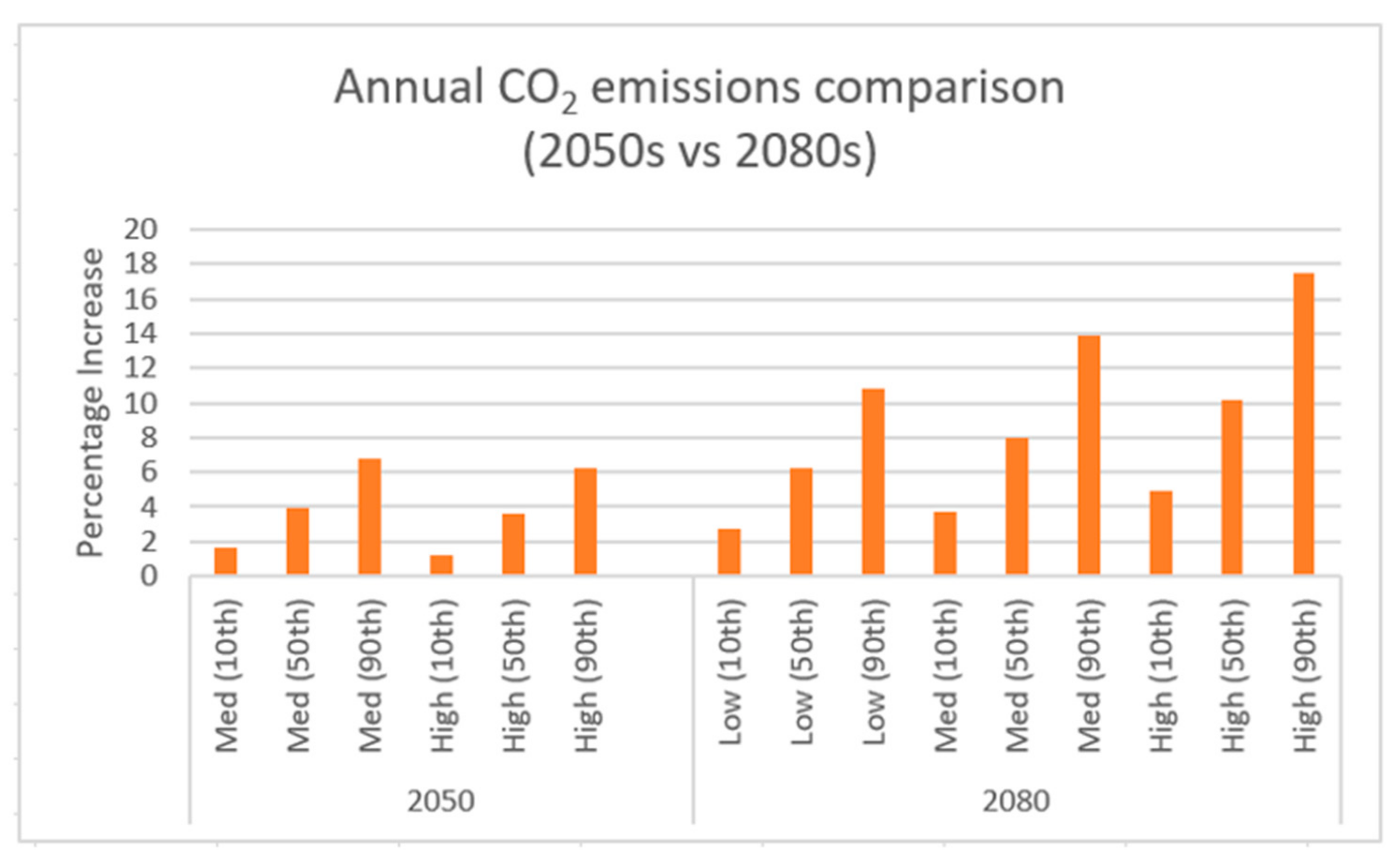
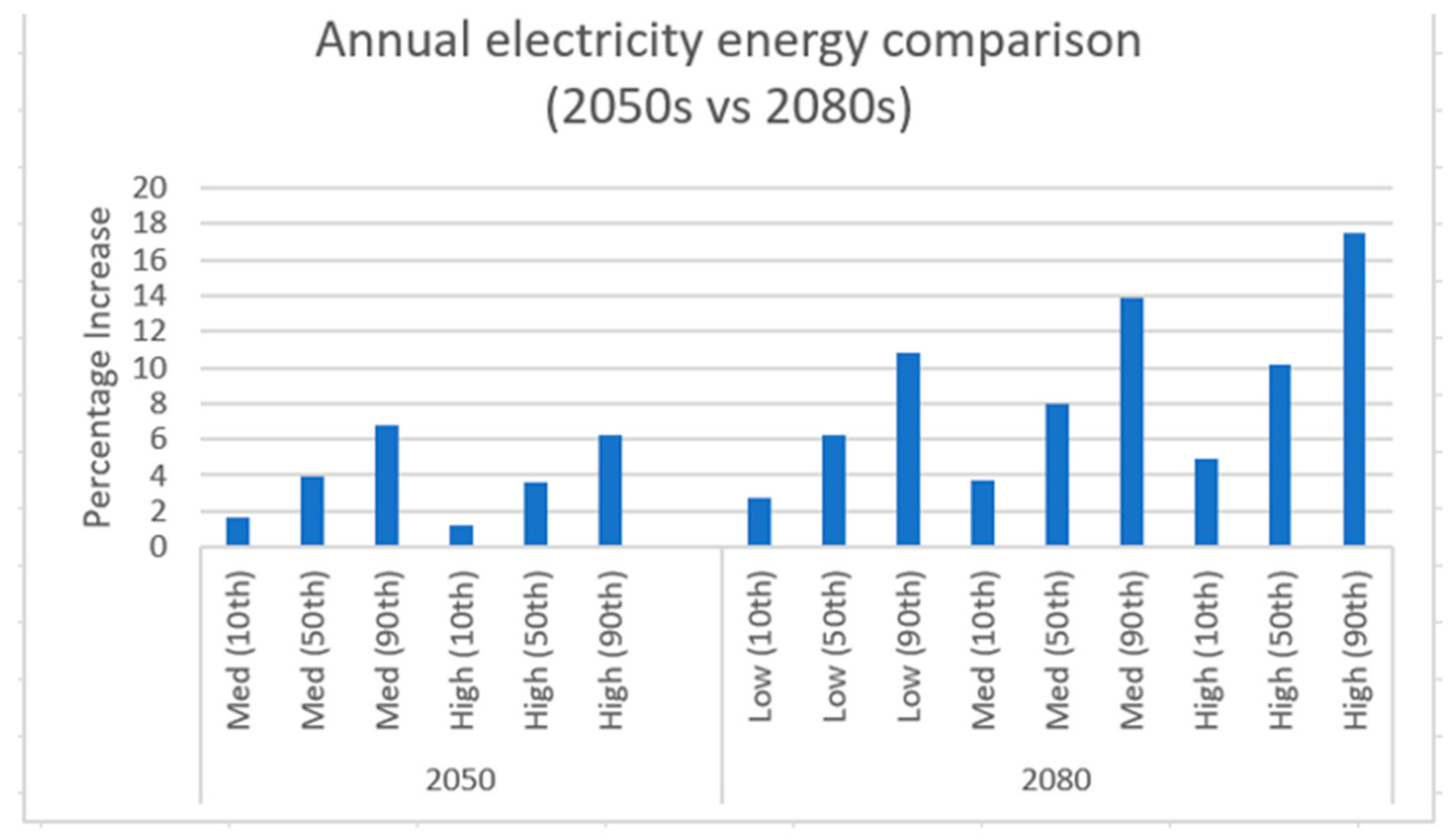
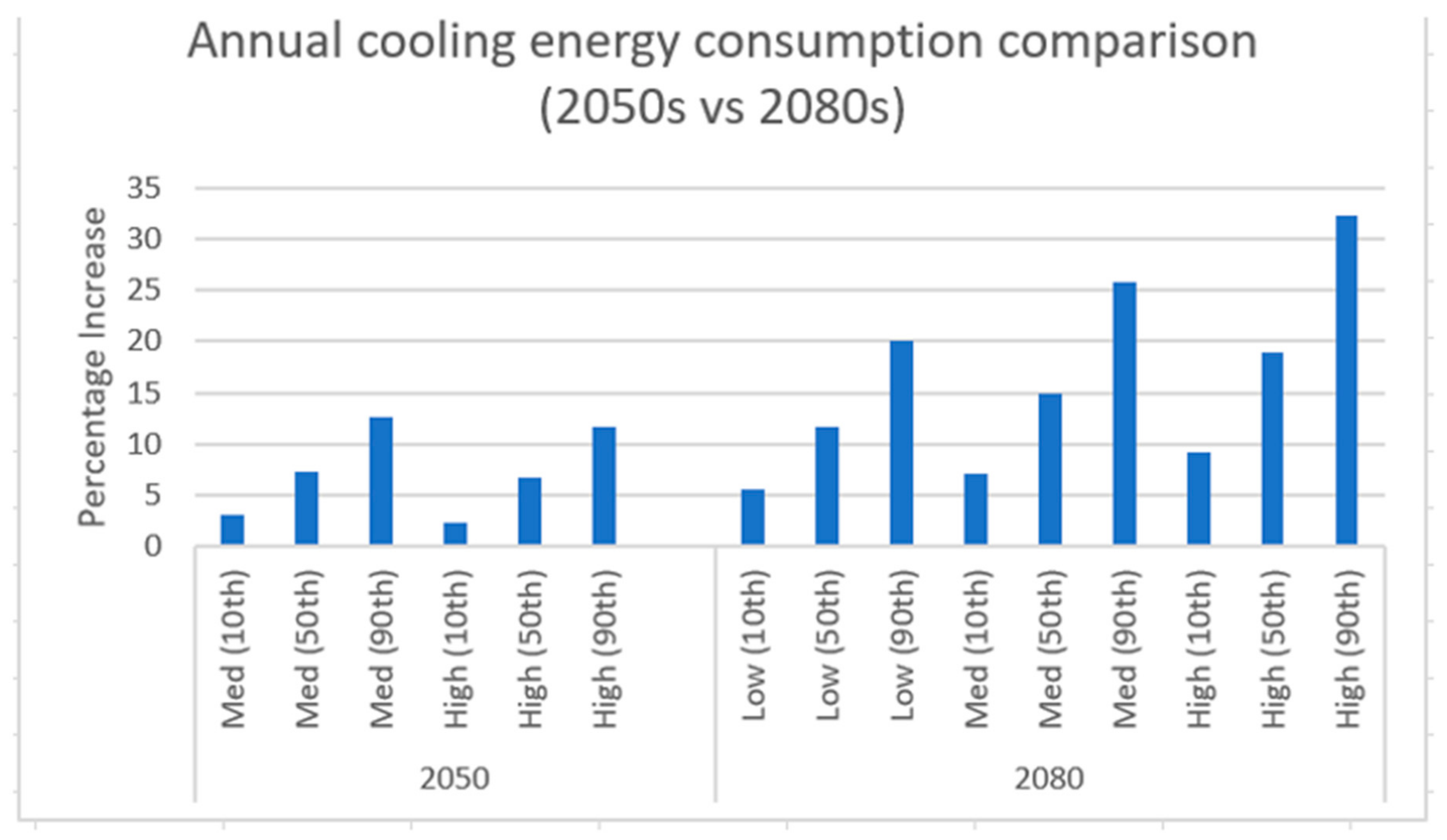
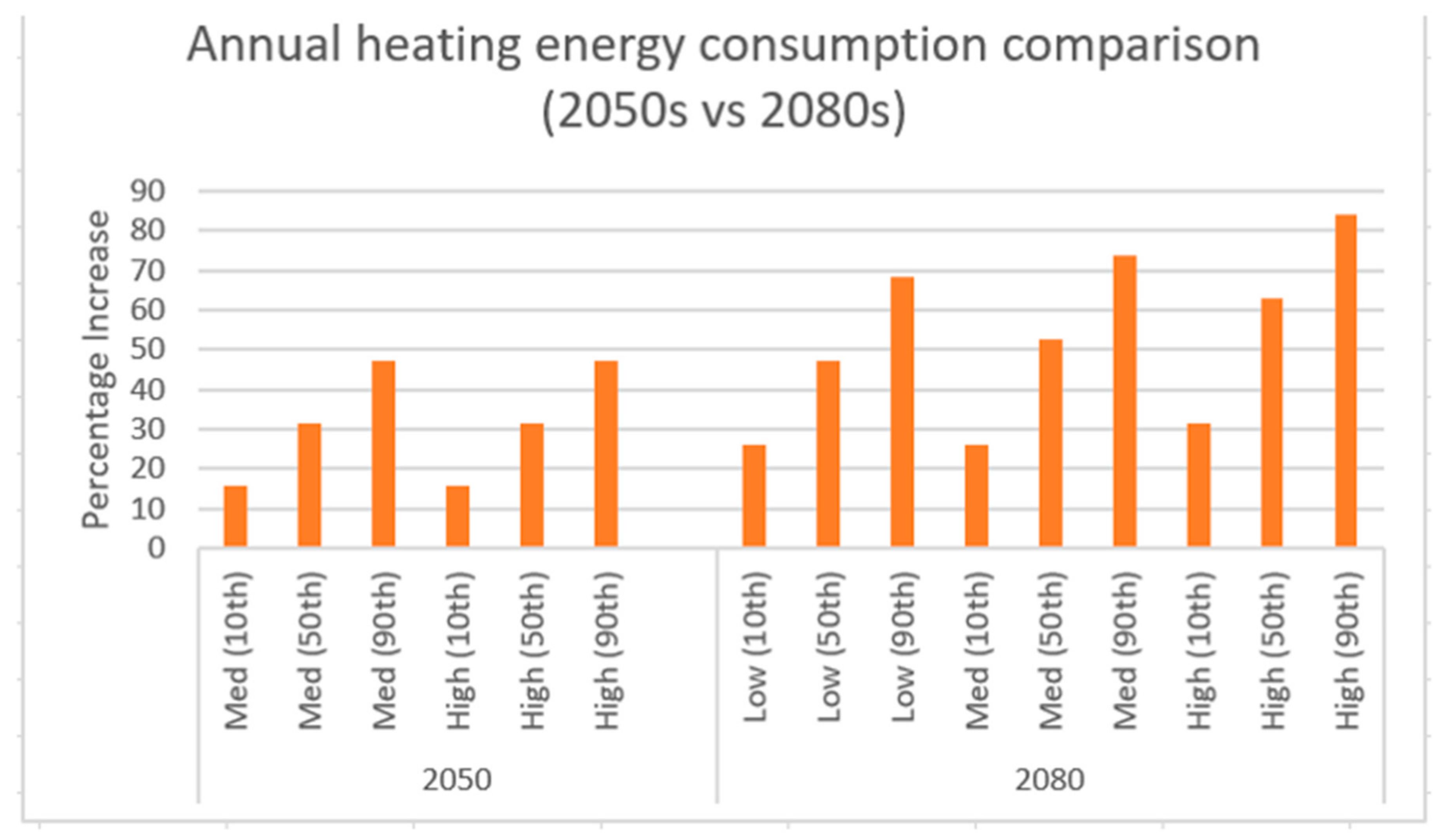
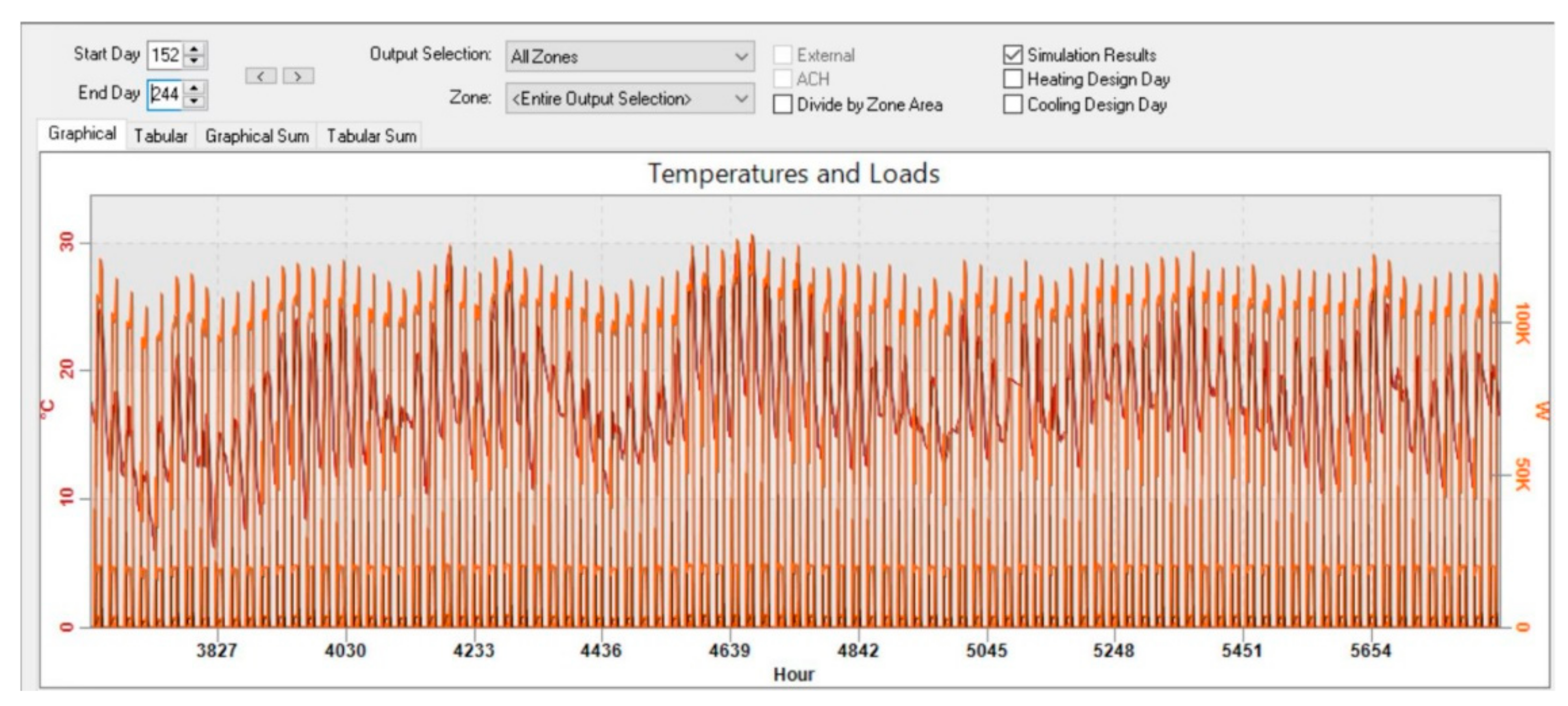
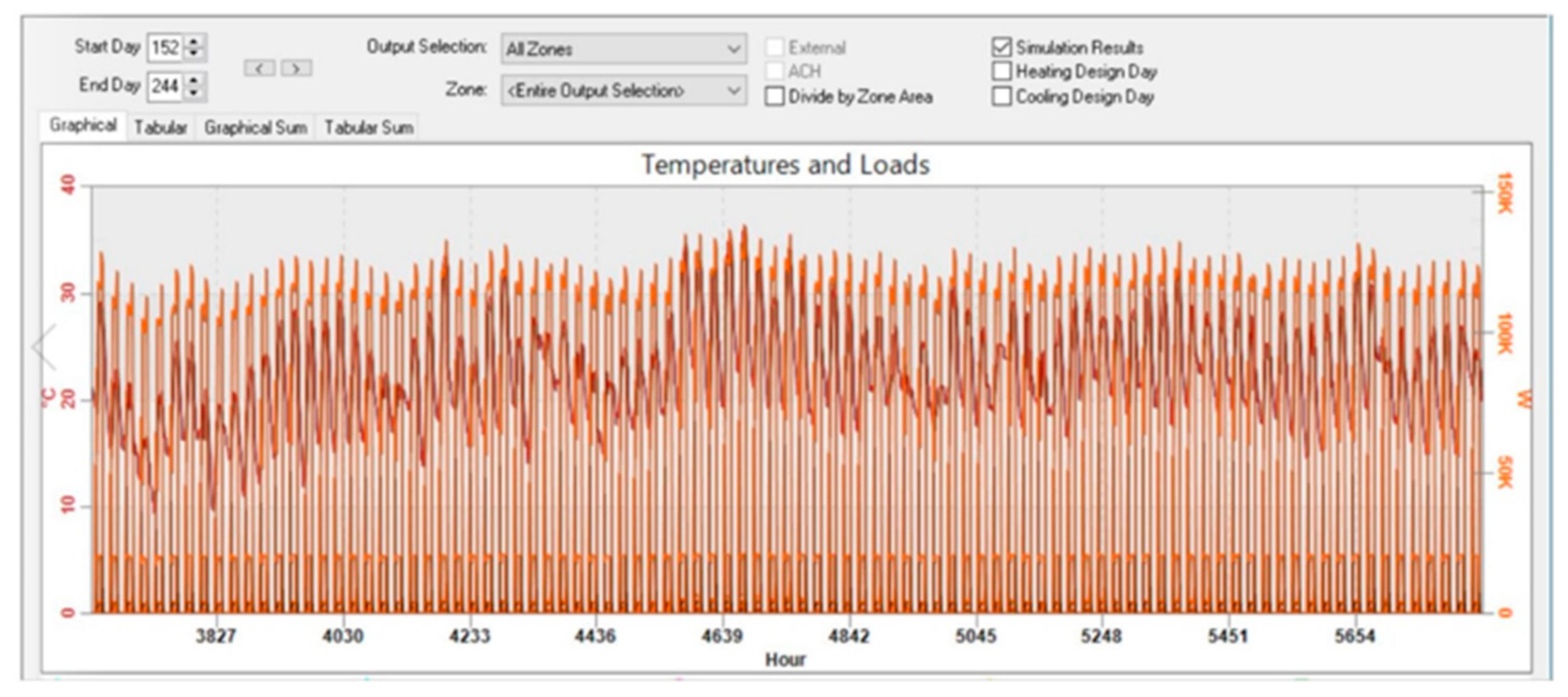

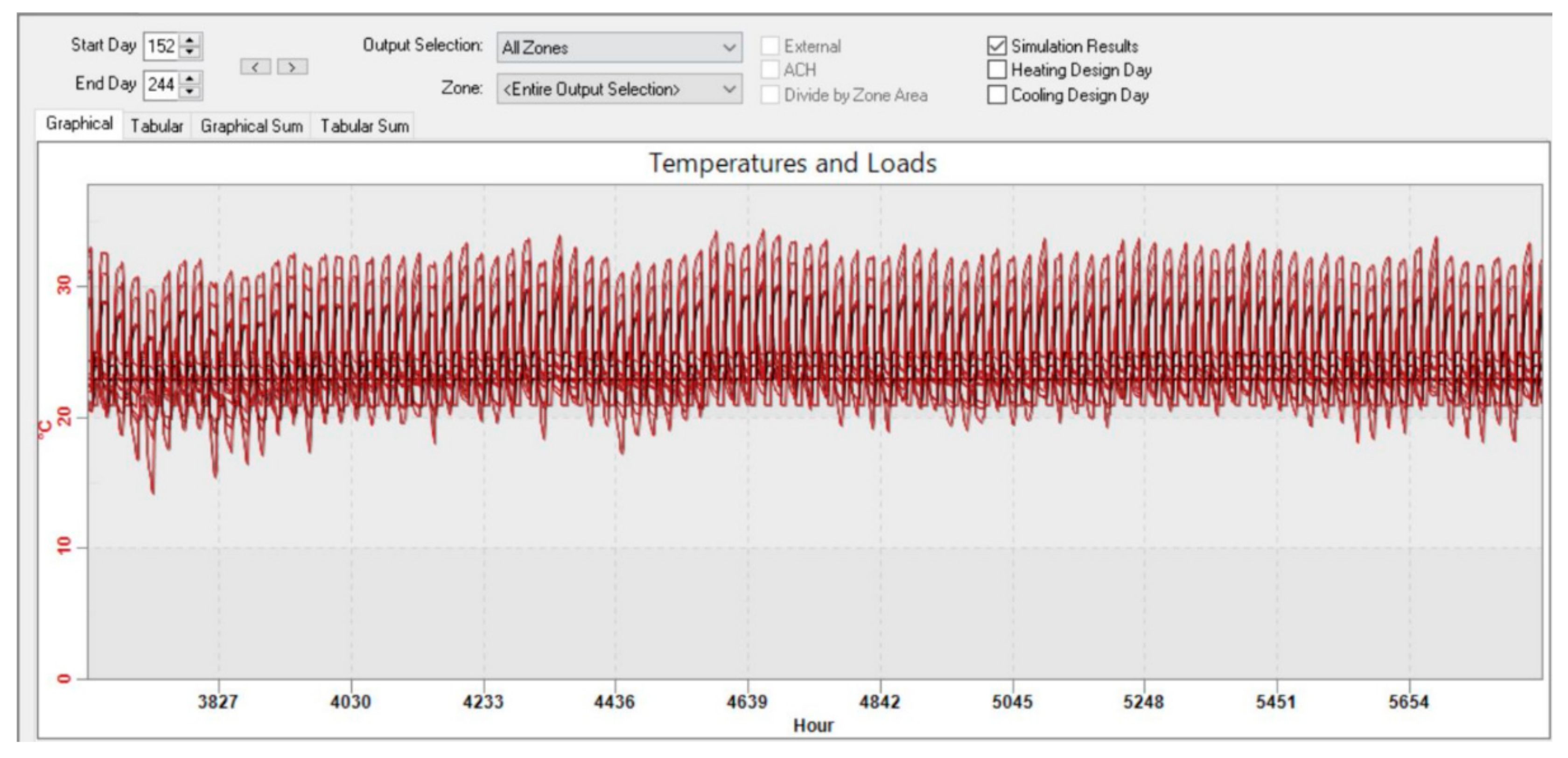
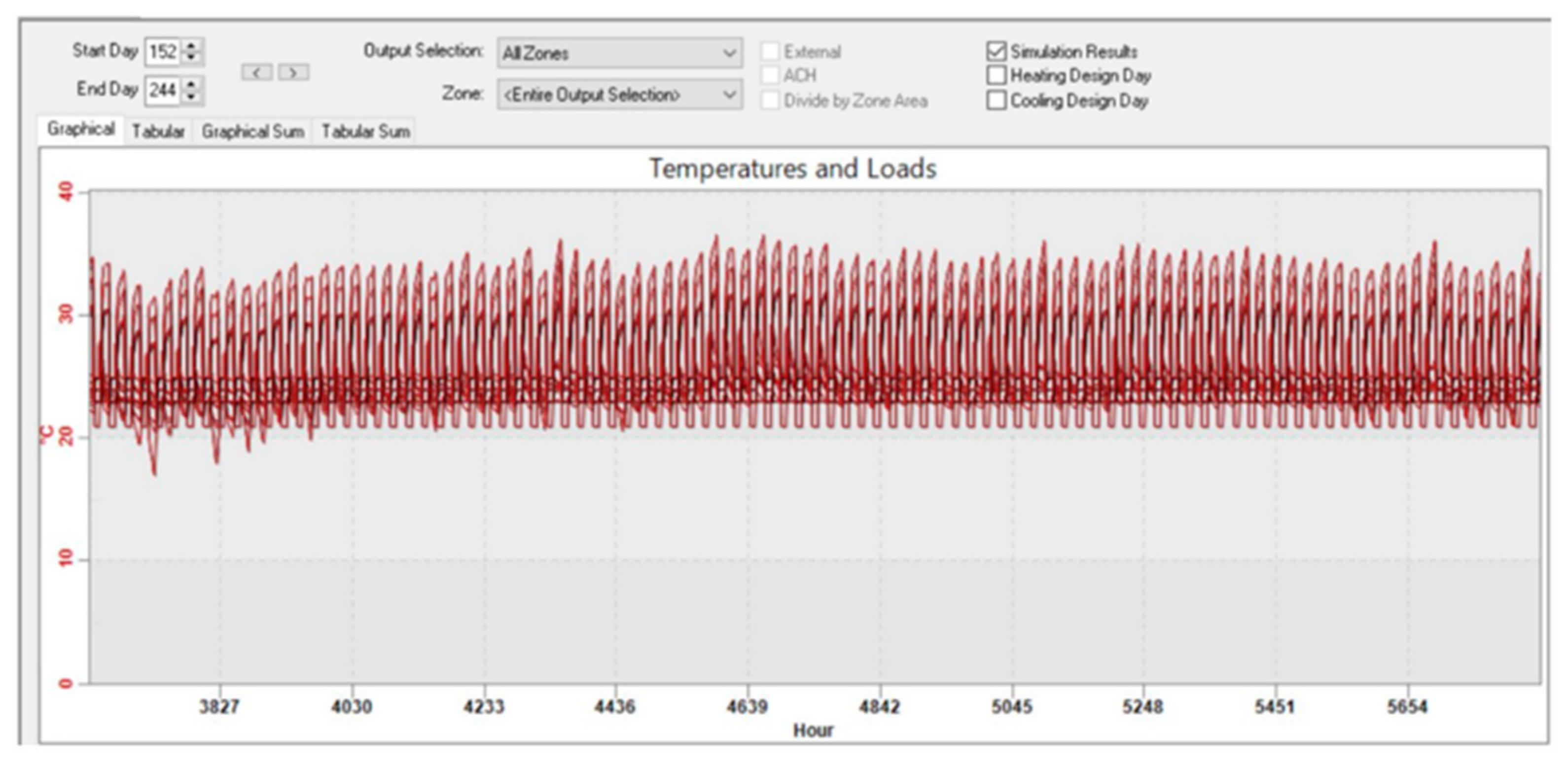
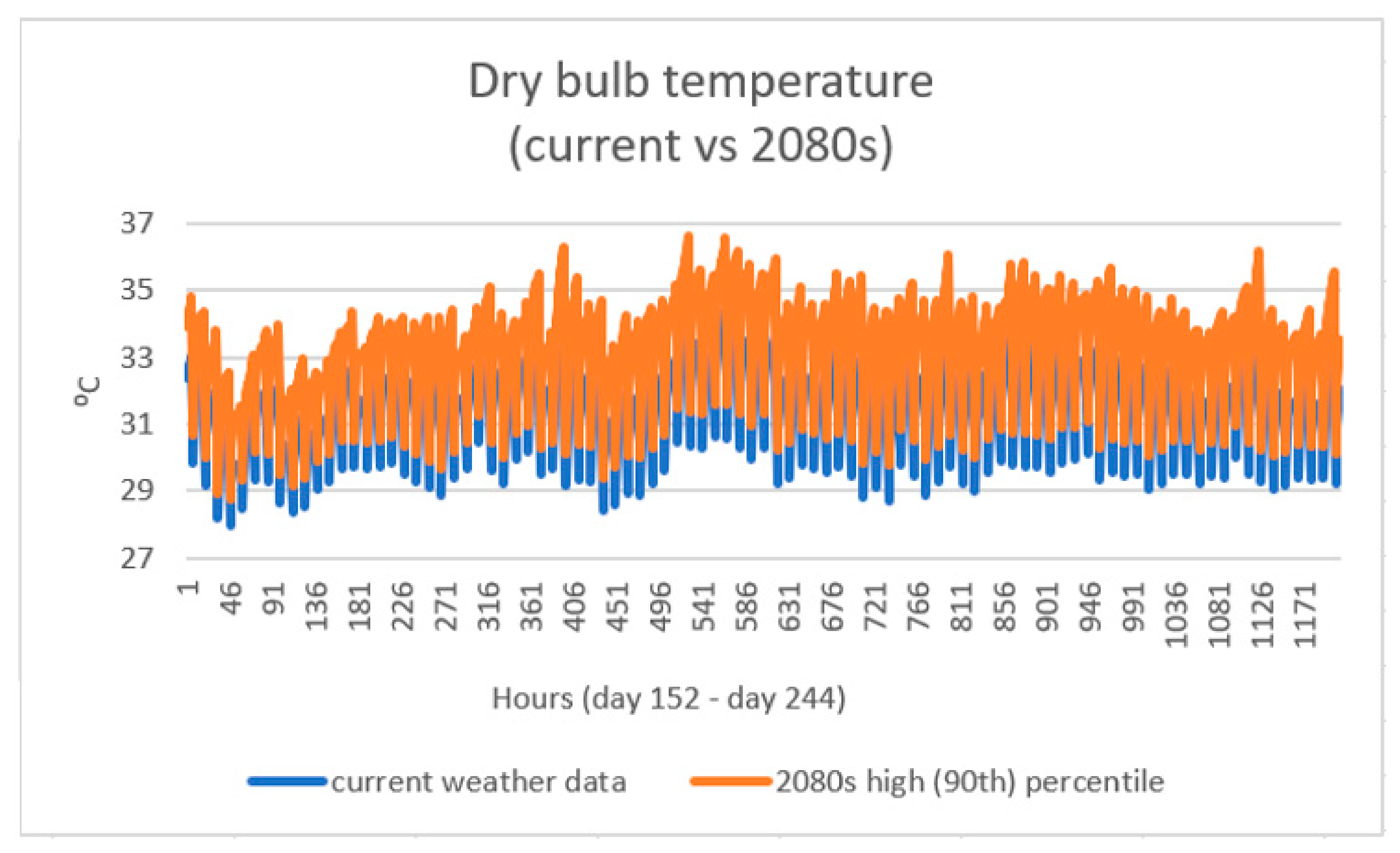
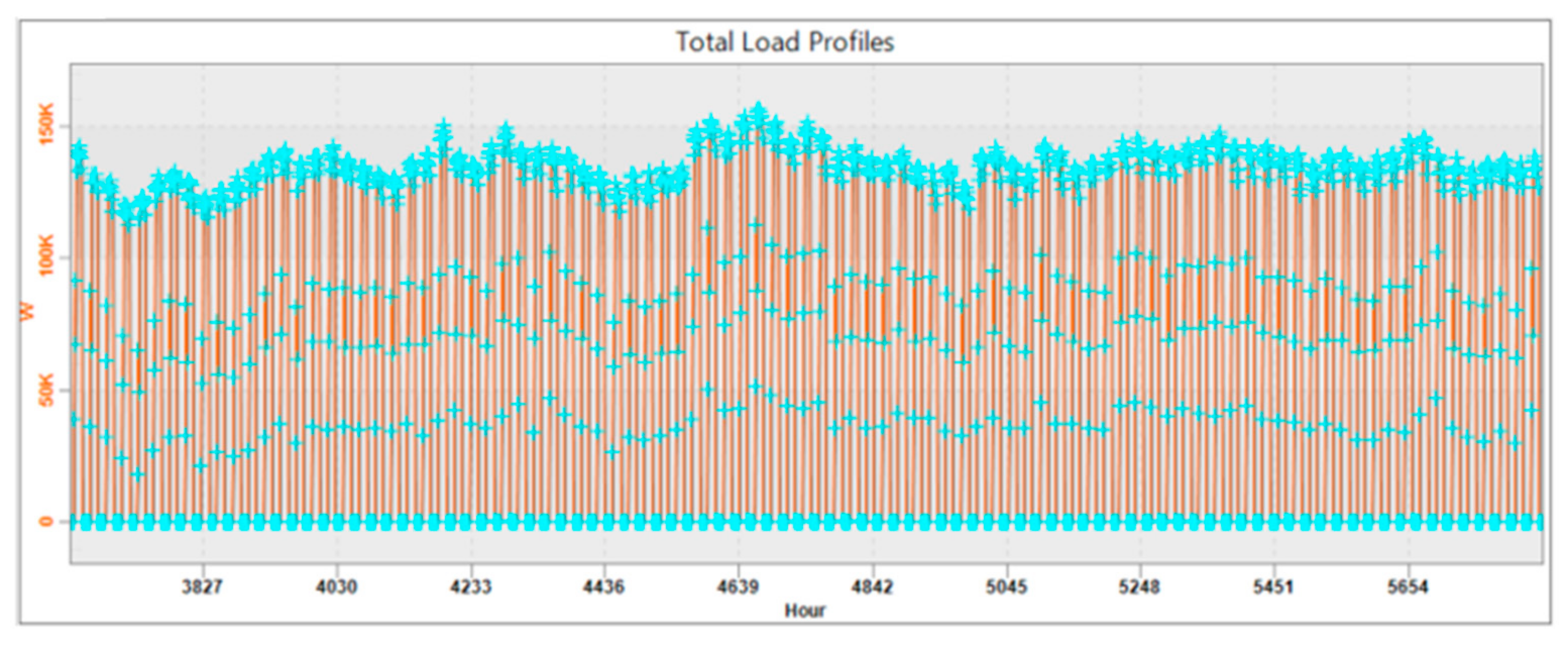
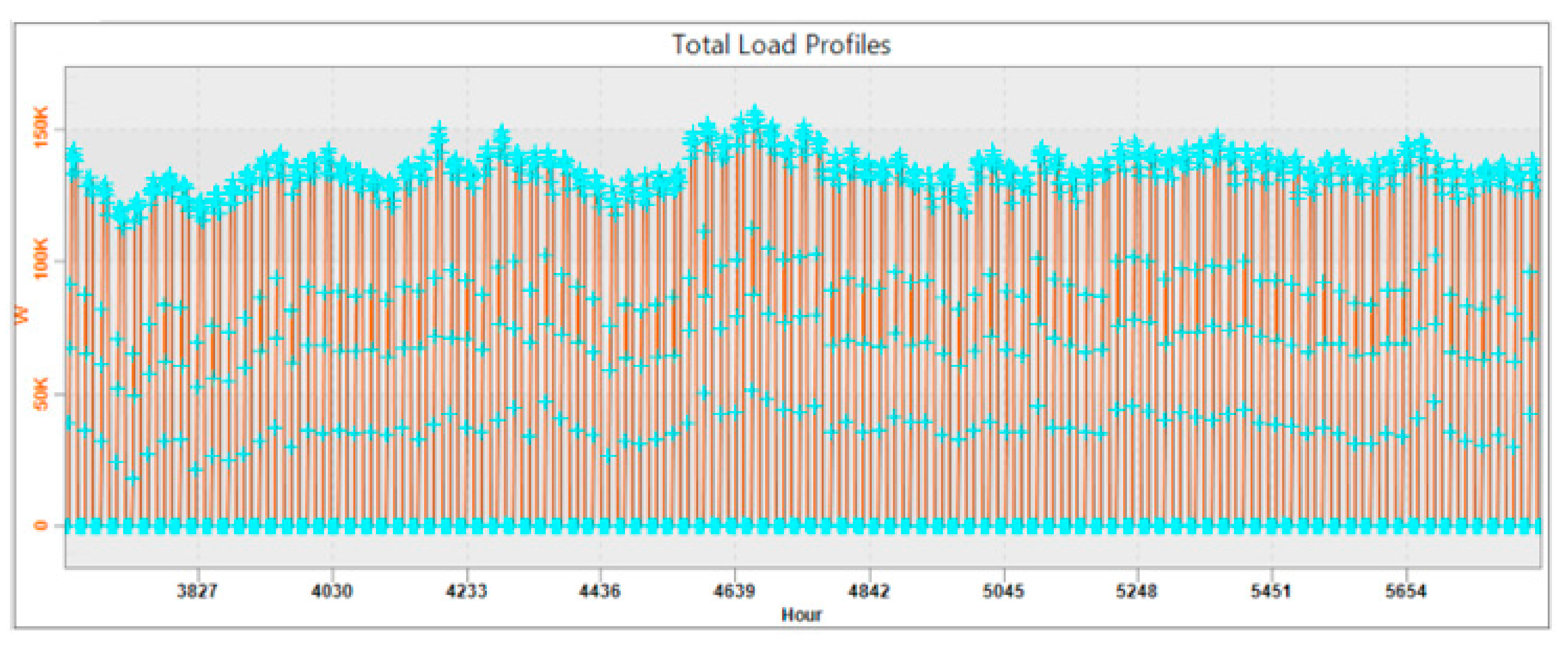
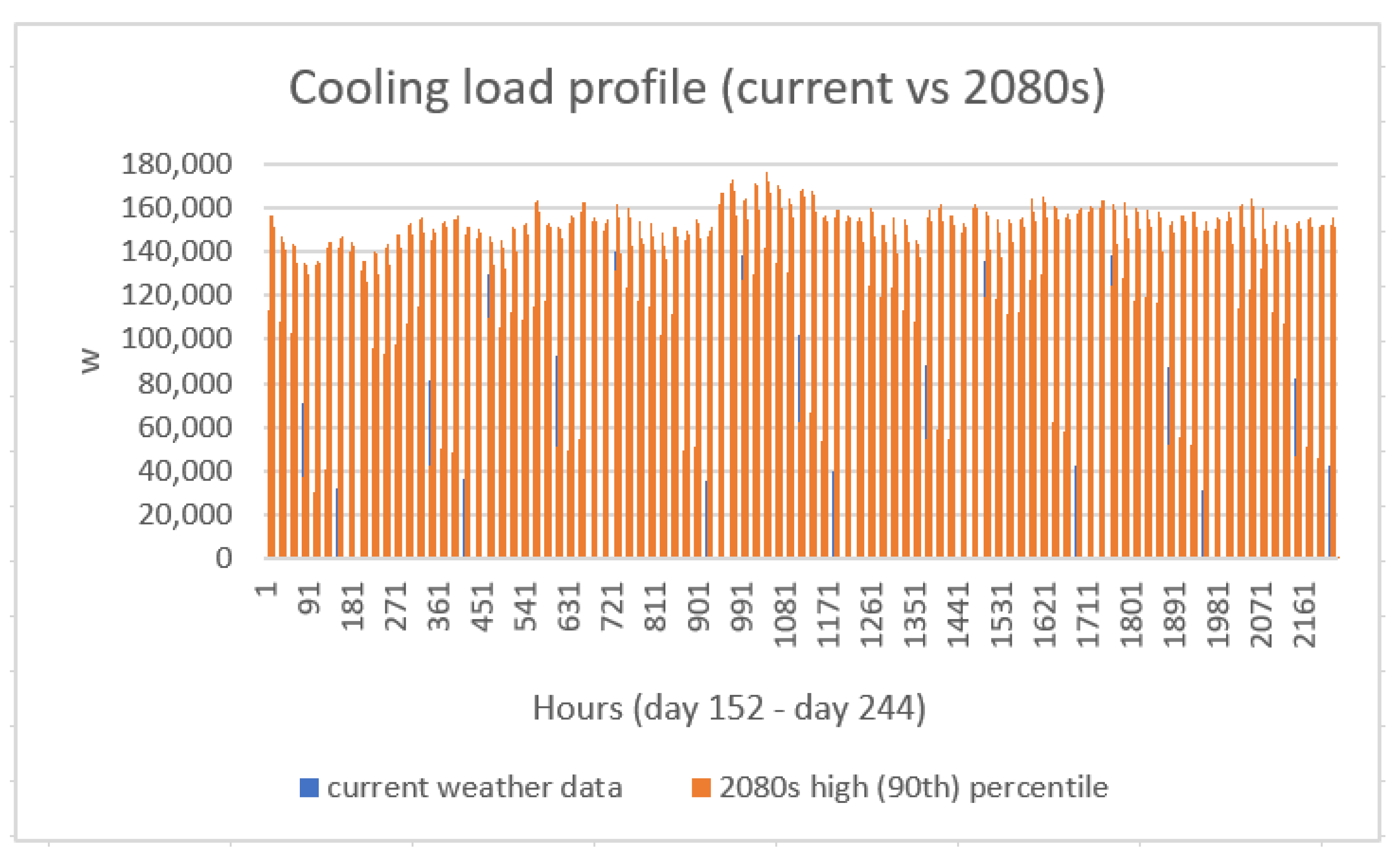
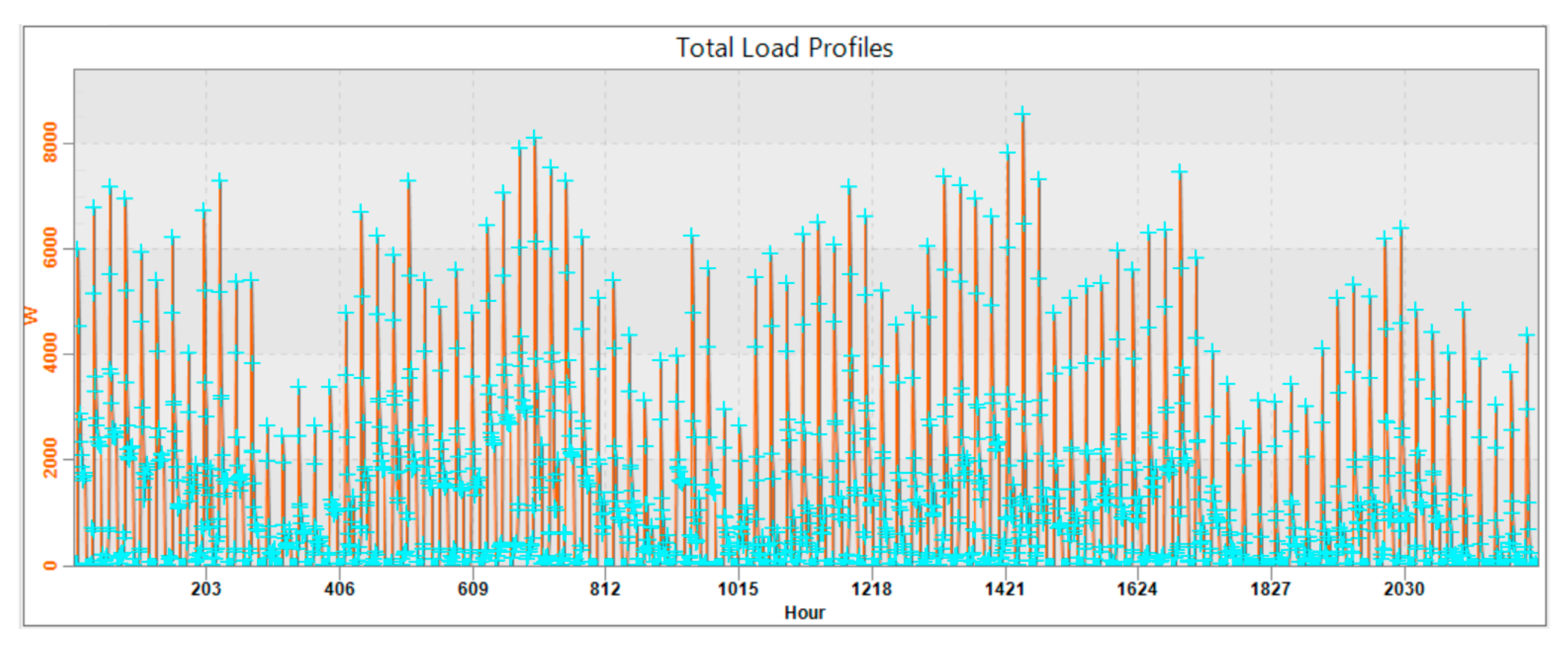

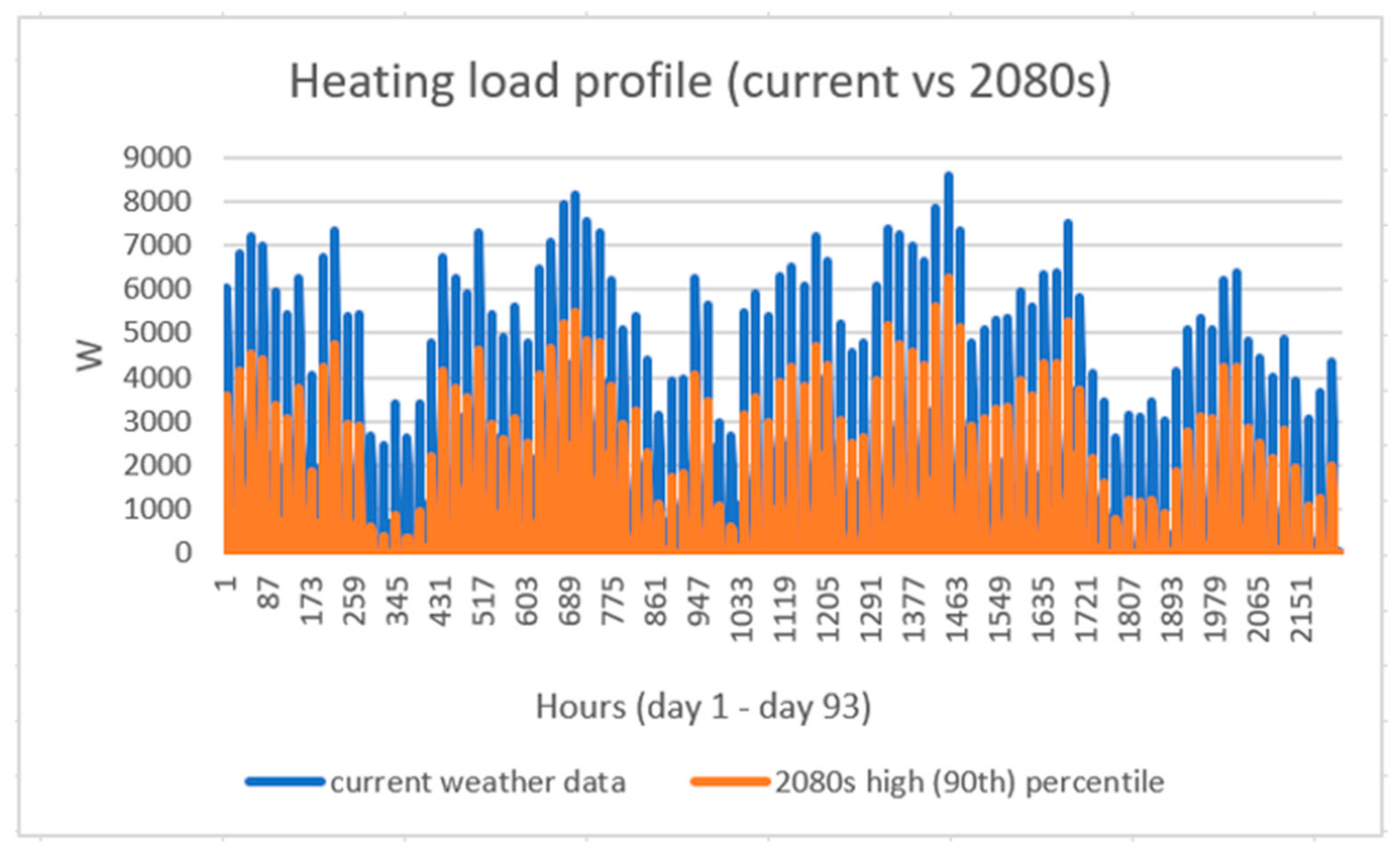
| 2046–2065 | 2081–2100 | ||||
|---|---|---|---|---|---|
| Global mean surface temperature change (°C) | Scenario | Mean | Likely Range | Mean | Likely Range |
| RCP 2.6 | 1.0 | 0.4 to 1.6 | 1.0 | 0.3 to 1.7 | |
| RCP 4.5 | 1.4 | 0.9 to 2.0 | 1.8 | 1.1 to 2.6 | |
| RCP 6.0 | 1.3 | 0.8 to 1.8 | 2.2 | 1.4 to 3.1 | |
| RCP 8.5 | 2.0 | 1.4 to2.6 | 3.7 | 2.6 to 4.8 | |
| Type | Conductance (W/m2. ⁰C) | Solar Absorptance | Emissivity | Time Constant | Construction Type | ||
|---|---|---|---|---|---|---|---|
| External/Internal | External/Internal | ||||||
| Wall | Cast Concrete wall | 0.974 | 0.700 | 0.900 | 4.169 | Opaque | |
| Cavity wall | 0.25 | 0.700 | 0.900 | 12.790 | Opaque | ||
| Curtain Wall | 5.227 | 0.700 | 0.900 | 0.0 | Opaque | ||
| Metal Cladding Wall | 0.235 | 0.700 | 0.900 | 0.0 | Opaque | ||
| Steel Frame Wall | 0.379 | 0.700 | 0.900 | 2.526 | Opaque | ||
| Frame | Uncoated glass, air-filled | 5.545 | 0.101 | 0.078 | 0.840 | 0.00 | Transparent |
| Metal, thermal break & spacer | 59.116 | 0.00 | 0.850 | 0.00 | Transparent | ||
| Wood, thermal spacer | 7.89 | 0.00 | 0.850 | 0.00 | Transparent | ||
| Floor | Ground Floor | 0.218 | 0.700 | 0.900 | 156.820 | Opaque | |
| Door | Insulated personal door | 0.94 | 0.700 | 0.900 | 0.00 | Opaque | |
| Vehicle door | 2.0 | 0.700 | 0.900 | 0.00 | Opaque | ||
| Building Element | Calculated Area-Weighted Average U-values (W/m2K) |
|---|---|
| Wall | 0.24 |
| Floor | 0.21 |
| Roof | 0.13 |
| Windows | 3.08 |
| Personnel doors | 1.32 |
| Vehicle access doors | 1.78 |
| High usage entrance doors | 3.34 |
| Calendar | NCM Standard |
|---|---|
| Air permeability | 4.0 m3/h.m2 @ 50Pa |
| Infiltration | 0.125 (ACH) |
| Fuel source | Grid supplied electricity |
| CO2 factor | 0.519 kg/kWh |
| Actual | Notional | |
|---|---|---|
| Heating + cooling demand (MJ/m2) | 594.54 | 599.9 |
| Primary energy (kWh/m2) | 348.99 | 306.81 |
| Total emissions (kg/m2) | 59 | 53.4 |
| Total Annual Energy Consumption (kWh/m2) | |||||||
|---|---|---|---|---|---|---|---|
| The 2050s | |||||||
| Baseline LIDL model | Current (kWh/m2) | Med (10th) | Med (50th) | Med (90th) | High (10th) | High (50th) | High (90th) |
| %Inc | %Inc | %Inc | %Inc | %Inc | %Inc | ||
| 98.63 | 1.80 | 4.12 | 7.01 | 1.46 | 3.80 | 6.45 | |
| Total Annual Energy Consumption (kWh/m2) | ||||||||||
|---|---|---|---|---|---|---|---|---|---|---|
| The 2080s | ||||||||||
| Baseline LIDL model | Current (kWh/m2) | Low (10th) | Low (50th) | Low (90th) | Med (10th) | Med (50th) | Med (90th) | High (10th) | High (50th) | High (90th) |
| %Inc | %Inc | %Inc | %Inc | %Inc | %Inc | %Inc | %Inc | %Inc | ||
| 98.63 | 2.92 | 6.48 | 11.05 | 3.96 | 8.22 | 14.07 | 5.14 | 10.36 | 17.68 | |
| Annual CO2 Emissions Comparison (kgCO2/m2) | |||||||
|---|---|---|---|---|---|---|---|
| The 2050s | |||||||
| Baseline LIDL model | Current (kgCO2/m2) | Med (10th) | Med (50th) | Med (90th) | High (10th) | High (50th) | High (90th) |
| % Inc | % Inc | % Inc | % Inc | % Inc | % Inc | ||
| 51.29 | 1.60 | 3.90 | 6.80 | 1.25 | 3.61 | 6.24 | |
| Annual CO2 Emissions Comparison (kgCO2/m2) | ||||||||||
|---|---|---|---|---|---|---|---|---|---|---|
| The 2080s | ||||||||||
| Baseline LIDL model | Current (kgCO2/m2) | Low (10th) | Low (50th) | Low (90th) | Med (10th) | Med (50th) | Med (90th) | High (10th) | High (50th) | High (90th) |
| %Inc | %Inc | %Inc | %Inc | %Inc | %Inc | %Inc | %Inc | %Inc | ||
| 51.29 | 2.71 | 6.26 | 10.84 | 3.76 | 8.01 | 13.84 | 4.93 | 10.14 | 17.45 | |
| Annual Electricity Energy Comparison (kWh/m2) | |||||||
|---|---|---|---|---|---|---|---|
| The 2050s | |||||||
| Baseline LIDL model | Current (kWh/m2) | Med (10th) | Med (50th) | Med (90th) | High (10th) | High (50th) | High (90th) |
| %Inc | %Inc | %Inc | %Inc | %Inc | %Inc | ||
| 303.39 | 1.61 | 3.91 | 6.80 | 1.26 | 3.60 | 6.24 | |
| Annual Electricity Energy Comparison (kWh/m2) | ||||||||||
|---|---|---|---|---|---|---|---|---|---|---|
| The 2080s | ||||||||||
| Baseline LIDL model | Current (kWh/m2) | Low (10th) | Low (50th) | Low (90th) | Med (10th) | Med (50th) | Med (90th) | High (10th) | High (50th) | High (90th) |
| %Inc | %Inc | %Inc | %Inc | %Inc | %Inc | %Inc | %Inc | %Inc | ||
| 303.39 | 2.72 | 6.27 | 10.83 | 3.76 | 8.01 | 13.85 | 4.93 | 10.14 | 17.45 | |
| Annual Cooling Energy Consumption comparison (kWh/m2) | |||||||
|---|---|---|---|---|---|---|---|
| The 2050s | |||||||
| Baseline LIDL model | Current (kWh/m2) | Med (10th) | Med (50th) | Med (90th) | High (10th) | High (50th) | High (90th) |
| %Inc | %Inc | %Inc | %Inc | %Inc | %Inc | ||
| 53.74 | 3.00 | 7.29 | 12.67 | 2.36 | 6.70 | 11.63 | |
| Annual Cooling Energy Consumption Comparison (kWh/m2) | ||||||||||
|---|---|---|---|---|---|---|---|---|---|---|
| The 2080s | ||||||||||
| Baseline LIDL model | Current (kWh/m2) | Low (10th) | Low (50th) | Low (90th) | Med (10th) | Med (50th) | Med (90th) | High (10th) | High (50th) | High (90th) |
| %Inc | %Inc | %Inc | %Inc | %Inc | %Inc | %Inc | %Inc | %Inc | ||
| 53.74 | 5.58 | 11.69 | 20.15 | 7.02 | 14.91 | 25.72 | 9.17 | 18.85 | 32.38 | |
| Annual Heating Energy Consumption Comparison (kWh/m2) | |||||||
|---|---|---|---|---|---|---|---|
| The 2050s | |||||||
| Baseline LIDL model | Current (kWh/m2) | Med (10th) | Med (50th) | Med (90th) | High (10th) | High (50th) | High (90th) |
| %Dec | %Dec | %Dec | %Dec | %Dec | %Dec | ||
| 0.19 | 15.79 | 31.58 | 47.37 | 15.79 | 31.58 | 47.37 | |
| Annual Heating Energy Consumption Comparison (kWh/m2) | ||||||||||
|---|---|---|---|---|---|---|---|---|---|---|
| The 2080s | ||||||||||
| Baseline LIDL model | Current (kWh/m2) | Low (10th) | Low (50th) | Low (90th) | Med (10th) | Med (50th) | Med (90th) | High (10th) | High (50th) | High (90th) |
| %Dec | %Dec | %Dec | %Dec | %Dec | %Dec | %Dec | %Dec | %Dec | ||
| 0.19 | 26.32 | 47.37 | 68.42 | 26.32 | 52.63 | 73.68 | 31.58 | 63.16 | 84.21 | |
Publisher’s Note: MDPI stays neutral with regard to jurisdictional claims in published maps and institutional affiliations. |
© 2020 by the authors. Licensee MDPI, Basel, Switzerland. This article is an open access article distributed under the terms and conditions of the Creative Commons Attribution (CC BY) license (http://creativecommons.org/licenses/by/4.0/).
Share and Cite
Hasan, A.; Bahadori-Jahromi, A.; Mylona, A.; Ferri, M.; Tahayori, H. Investigating the Potential Impact of Future Climate Change on UK Supermarket Building Performance. Sustainability 2021, 13, 33. https://doi.org/10.3390/su13010033
Hasan A, Bahadori-Jahromi A, Mylona A, Ferri M, Tahayori H. Investigating the Potential Impact of Future Climate Change on UK Supermarket Building Performance. Sustainability. 2021; 13(1):33. https://doi.org/10.3390/su13010033
Chicago/Turabian StyleHasan, Agha, Ali Bahadori-Jahromi, Anastasia Mylona, Marco Ferri, and Hooman Tahayori. 2021. "Investigating the Potential Impact of Future Climate Change on UK Supermarket Building Performance" Sustainability 13, no. 1: 33. https://doi.org/10.3390/su13010033
APA StyleHasan, A., Bahadori-Jahromi, A., Mylona, A., Ferri, M., & Tahayori, H. (2021). Investigating the Potential Impact of Future Climate Change on UK Supermarket Building Performance. Sustainability, 13(1), 33. https://doi.org/10.3390/su13010033






